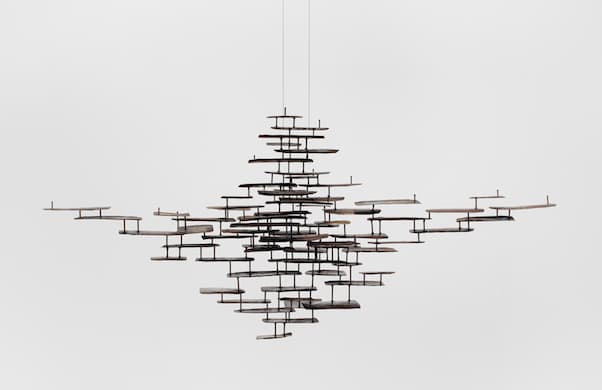Sculptor Harold Cousins Made Emptiness Take Shape
‘Forms of Empty Space’ is only the second occasion in which this American in Paris has been feted with a one-man exhibition in New York City.

“Harold Cousins: Forms of Empty Space,” an exhibition that recently opened at Michael Rosenfeld Gallery in Chelsea, prompts thoughts about “The Embrace,” by Hank Willis Thomas. The latter is the monument to Martin Luther King Jr. recently installed in Boston Commons that has engendered a lot of comment and significant enmity.
Comparisons between the two artists are justified not just because Harold Cousins (1916-92) and Mr. Thomas are African-Americans but because of their distinct and, in the end, irreconcilable aesthetic dissimilarities.
Mr. Thomas is a conceptual artist, a figure for whom the physical properties of art play a distant second fiddle to ideas. Cousins was a sculptor for whom the properties and possibilities of his metier were paramount. The difference between an artist who condescends to materials and one who elaborates on their metaphorical properties is vital. Theory and practice are two very different things.
Cousins is a talent well worth discovering. Although his work has been displayed piecemeal over the years — a handful of Cousins’s pieces were the highlight of “Explorations in the City of Light; African-American Artists in Paris, 1945–1965,” a show seen at the Studio Museum at Harlem in 1996 — “Forms of Empty Space” is only the second occasion in which he’s been feted with a one-man exhibition in New York City, the previous also having been mounted by Rosenfeld.
With the push for inclusion and equity in our cultural institutions, one would think the Whitney Museum, say, would’ve seen fit to give its nod to this particular American in Paris. Yet Cousins’s work doesn’t readily lend itself to the ideological prerogatives of our curatorial classes. Three cheers, then, for a commercial sector that has the wherewithal to go where our local museums seem too blind-sided to tread.
Born at Washington, D.C., Cousins attended Howard University and served in the Marines during World War II. He took a cue from colleagues like Ed Clark and Loïs Mailou Jones, as well as precedents set by Josephine Baker and a host of jazz musicians, and moved to France. Although not altogether free of racism, La Ville Lumièr allowed for a community in which, as Clark put it, “one was hated as an equal.”
Cousins studied with Ossip Zadkine, a Russian-born artist whose style of teaching he described as “bruising.” It was at Zadkine’s Montparnasse studio that Cousins met Shinkichi Tajiri, a sculptor who worked with an oxyacetylene torch, a tool that coincided with Cousins’s burgeoning interest in the welded metal effigies of Julio González.
The title for the current exhibition is excerpted from a Cousins quotation that is as good as any in describing the notion of “drawing in space”: “… giving special attention to the form of the empty space between the solid elements of a sculpture, as well as to the empty space surrounding the sculpture.” The 30 pieces on display, as well as an attendant set of preparatory drawings, put a premium on line rather than mass — focusing, instead, on the interstices between shapes.
Early diminutive pieces, like the delightfully concise “Bird of Prey” (circa 1951), evince a debt to Paul Klee, as well as an abiding interest in the art of non-Western cultures. (The Musée de l’Homme was a favorite haunt.) The rigors of Cousins’s day job — he earned his keep as a maker of jewelry — are apparent in the delicacy of his soldering and the deliberation by which forms are choreographed and connected.
The plaitons, a series that set flattened planar forms against filaments of steel, is best seen in “Untitled (Suspendu Plaiton)” (c. 1968). Here, the work’s construction is openly revealed by its being suspended from the ceiling, making for an airy edifice that recalls the expansiveness of Monet’s water lilies, the iconography of pre-Christian civilizations, and the crystallizing dynamism of organic phenomena.
Not everything at Rosenfeld achieves this kind of lyricism. The works-on-paper are, at best, honorable, and the wall pieces sometimes settle for the overly literal or the merely decorative. Yet Cousins deserves a seat at the table, his work holding its own with that of worthies such as Alexander Calder, Richard Stankiewicz, and David Smith. “Forms of Empty Space” is recommended to anyone with an abiding interest in the byways of 20th century art.

